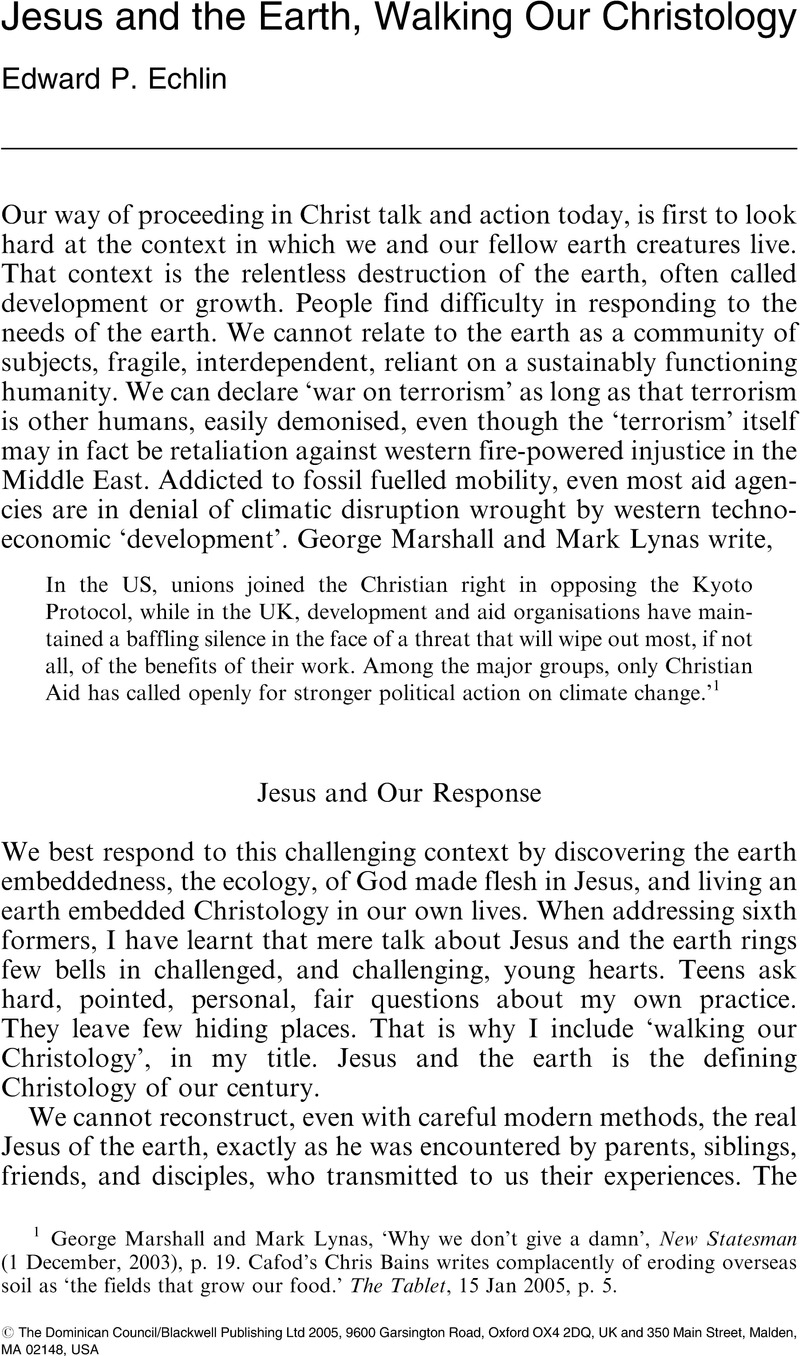No CrossRef data available.
Article contents
Jesus and the Earth, Walking Our Christology
Published online by Cambridge University Press: 01 January 2024
Abstract

- Type
- Original Articles
- Information
- Copyright
- Copyright © The Dominican Council/Blackwell Publishing Ltd 2005
References
1 George Marshall and Mark Lynas, ‘Why we don’t give a damn’, New Statesman(1 December, 2003), p. 19. Cafod's Chris Bains writes complacently of eroding overseas soil as ‘the fields that grow our food.’The Tablet, 15 Jan 2005, p. 5.
2 Schweitzer, Albert, The Quest for the Historical Jesus: A Critical Study of Its Progress from Reimarus to Wrede(London, 1954), p. 401Google Scholar.
3 Käsemann, Ernst, ‘The Problem of the Historical Jesus’, in The Historical Jesus Quest, Landmarks in the Search for the Jesus of History, Dawes, Gregory W., ed., (Louisville, Westminster John Knox Press, 2003), p. 290Google Scholar.
4 Cullinan, Cormac, Wild Law, A Manifesto for Earth Justice(Dartington, Green Books, 2003), p. 206Google Scholar.
5 Dupuis, Jacques S.J., Christianity and the Religions, From Confrontation to Dialogue, (Maryknoll, Orbis, 2001), p. 202Google Scholar.
6 In Bastaire, Hélène et Jean, Le Chant des créatures(Paris, Cerf, 1996), p. 49Google Scholar.
7 Rahner, Karl, ‘The Theology of the Religious Meaning of Images’, in Theological Investigations, vol. 23, Donceel, Joseph S.J., and Riley, Hugh, eds. (Crossroads, N.Y., 1992), p. 150Google Scholar.
8 Reed, Jonathan, Archaeology and the Galilee Jesus, a Re‐examination of the Evidence(Harrisburg, Trinity Press, 2000), p. 132Google Scholar.
9 Millstone, Erik & Lang, Tim, The Atlas of Food, Who Eats What, Where and Why’(London, Earthscan, 2003), p. 67Google Scholar.
10 Rahner, Karl, ‘Priest and Poet’, Theological Investigations, vol. 3, Karl, and Kruger, Boniface, eds. (N.Y., Seabury, 1974), p. 296Google Scholar.
11 Joseph O’Hanlon, ‘A Glass of Blessings Standing By. … .’, Doctrine and Life(January 2004), p. 12.
12 Pope John Paul II, ‘Message to the Scouts’, The Ark(Spring, 2004), p. 16.
13 Surette, John S.J., ‘Relationship between earth and humans as a defining issue’, National Jesuit News(December, 2003), p. 18Google Scholar; cf. also Grey, Mary C., Sacred Longings, Ecofeminist Theology and Globalization(London, SCM Press, 2003) pp. 116–119Google Scholar.
14 Johnson, Elizabeth, Truly our Sister, A Theology of Mary in the Communion of Saints(N.Y., Continuum, 2003), p. 111Google Scholar.
15 Wright, N.T., The Resurrection of the Son of God(London, SPCK, 2003) p. 730Google Scholar.


